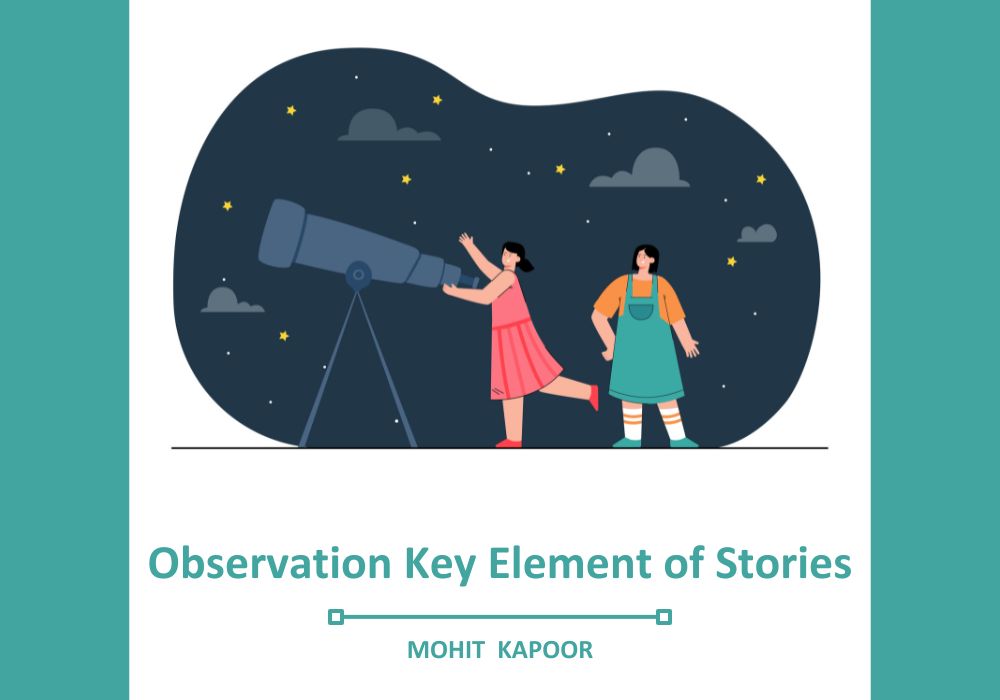In storytelling, observation is the spark — the moment of noticing something specific and meaningful in the world, your environment, people, data, behavior, or even yourself.
But here’s the key:
“Sharp observation isn’t about what’s visible — it’s about catching the quiet signals that others can’t see”
“It’s less about what happened — and more about what it quietly revealed.”
Why Most People Struggle with Observations
Because we’ve been trained to:
- Focus on outcomes, not moments
- Generalize, not personalize
- Rush, not reflect
That’s why a lot of stories sound generic or “meh.” The starting point lacks soul. It’s too surface-level.
So, How Do You Improve Your Observations?
Let’s break this into 3 actionable levels: Mindset → Habits → Practice
1. Upgrade Your Mindset: From Passive to Active Noticer
Great storytellers see the world in layers. They don’t just look — they decode.
Try this shift:
- From: “What happened?”
- To: “What’s really happening beneath what I see?”
Example: Someone yawns in a meeting. Most ignore it.
An observant storyteller might think: “Is it boredom, burnout, or maybe they’ve been up all night with a newborn?” That’s a scene starter.
2. Build Habits That Train Your Observational Muscle
A. Slow down and document
“Keep a daily log of quick-hit moments — sharp details you notice, which most people miss.” No pressure to turn them into anything.
“Saw a dad teaching his kid how to swim, but only using words, not action.
It said more about how we lead, what we avoid, and why words sometimes get in the way of real action.”
B. Ask reflective questions every day:
- What stood out today?
- What did I feel, but not say?
- What small tension did I notice in others?
C. Use mental filters like:
- Behavior vs Intention: What are they doing vs what they might be feeling?
- Pattern Interrupts: When something doesn’t go as expected, dig in. That’s story fuel.
3. Practice Turning Observations Into Openings
This is where it gets powerful for storytelling in content, marketing, or public speaking.
Take this plain sentence:
“We were missing our Q1 targets — not by a mile, but just enough to spark silence on the Monday call.”
Now layer it with observation:
“Everyone was nodding in sync during the Monday call — but Slack told a different story by noon. Silent stress, fake alignment, and missed targets. That’s when I knew we had a trust issue, not a KPI issue.”
Boom. That’s an opening people feel.
Bonus: Framework to Strengthen Observation
Use this framework when reflecting on your day or prepping a story:
OBSERVE → FEEL → CONNECT → EXPAND
- Observe: What moment stuck with me today?
- Feel: What emotion or tension did it carry?
- Connect: What deeper human truth does this reflect?
- Expand: How can this relate to my audience or message?
Real-World Use Case: For Marketers Like You
Let’s say you’re writing a LinkedIn post about retention challenges.
Instead of starting with:
“Most SaaS teams don’t lose customers because the product is broken — they lose them in the quiet weeks after sign-up.”
Try:
“I saw it happen again — the 2nd month in a row where our most active users churned after getting exactly what they signed up for. That’s when it hit me: maybe the problem isn’t product gaps, but post-conversion silence.”
That observation = instant hook + real tension + leads into a story worth reading.
Final Takeaway
Observation isn’t passive — it’s a discipline.
It’s the storyteller’s radar. The better you get at noticing small truths, emotional beats, or unexpected behavior, the more magnetic your stories become.
Want to be unforgettable?
Start seeing what others overlook — and put it into words that resonate.

Leave a Reply